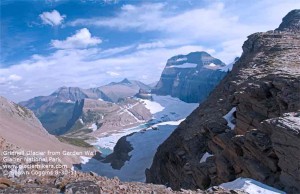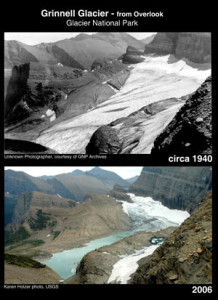No one denies “the greenhouse effect.” We can observe it in greenhouses. But we are scientists, and we are scientifically skeptical of claims by government-friendly alarmists who claim that humanity must adopt various repeatedly-failed socialist policies in order to save the planet from manmade global warming.
BY TAKING PHOTOS EVERY JULY 24TH
Al Gore’s Nobel Prize-winning film, lecture series, and “movement” to push for more socialism to counter manmade global warming specifically pointed to Glacier National Park as “ground zero” for proving or framing the issue. Gore has made several specific claims about what will happen to the glaciers in Glacier National Park. Gore’s film An Inconvenient Truth cited Glacier National Park (and the Park’s Grinnell Glacier) as its second piece of evidence in support of the manmade global warming theory (the first being Mount Kilimanjaro).
The New York Times, like many other pro-government sources, has claimed that the glaciers in Glacier National Park will likely be gone “[i]n 30 years” or so, because of human production of CO2.
We do not deny that there has been melting of glaciers in Glacier Park over the past century. However, it is easy to be swayed by suggestive photographs of Glacier Park snowfields that appear to show that Glacier Park’s snowfields are vanishing entirely. Often these photos are taken during the height of recent very hot summers and compared to photos taken during other seasons of the year in the past—and presented without specifying dates!
For example, the government’s USGS Northern Rocky Mountain Science Center (NOROCK) website shows two photos (above on the right) of the Grinnell Glacier (one purportedly from “circa 1940” and the other from 1996 (a very warm year). Notice that no specific dates are provided.
Those of us who live in Montana know that all of the high-elevation mountains around us are covered with ice and snow in winter and that they then shed all or most of this snow–down to various permanent snowfields and glaciers–by summers’ ends.
The USGS purports to have a “project” (probably costing taxpayers many thousands of dollars annually) which emphasizes “repeat photography” of the same Glacier Park locations for “communicating effects of global warming”. The Project does not appear to spend much energy on specifying dates.
But a wealth of conflicting imagery is provided by typing the words “Grinnell Glacier” into online search engines. One may find dozens of recent (post-2006) images of the Grinnell Glacier which appear to show the Grinnell Glacier LARGER, not smaller than it appeared in the USGS’ 2006 “repeat photography” image. See, for example, the image on the left above, apparently taken by someone in August 2011.
Such research can be done without ever setting foot on the Overlook Trail above Grinnell Glacier. However, it would be good to record imagery from similar vantage points every year on the same date.
LYSANDER SPOONER UNIVERSITY PROPOSES ITS OWN RESEARCH PROJECT: To have multiple photographers record images of Grinnell Glacier (and other glacial sites in and out of Glacier National Park) every year on the same (traditionally hot summer) date. According to the meteorologists at weatherbug.com, the hottest date of the year tends to be around July 24th.
Will you commit to taking an accurate photo of a prominent glacial location on July 24th and sending it to us? Email us at [email protected] to coordinate.



